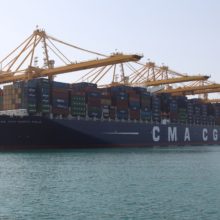
Speaking at October’s Mediterranean Ports Conference in Barcelona, Dorota Jilli, a Senior Underwriter at TT Club, outlined the insurer’s broad approach to the risks presented in the port environment, borne out of the benefit of TT Club’s vast experience of providing cover to a large variety of port authorities and terminal operators around the globe. Apart from assessing the differing business models and activities, the Club also carries out detailed analysis of historical claims of all types including property, liability and bodily injury, in order to provide effective advice on loss prevention and risk management.
“The risk profile of ports and terminals can be measured against a basic matrix,” said Jilli in her presentation. “For example, cargo handling operations will fall into a higher end of risk assessment if they have poor equipment maintenance or lack staff training regimes. A culture of favouring productivity over safety, or scant attention to security are key characteristics of higher risk operations.”
For landlord port authorities, which don’t provide operational services but grant concessions to operators, heightened risk factors include poorly constructed contracts with concessionaires or other port community stakeholders. A lack of emergency response protocols or clarity of interface with other port service providers also lead to greater risk.
Those operations that are found at the lower end of the risk spectrum feature well-trained and motivated workforce and a management culture with commitment to safety, properly maintained equipment and secure premises. In the case of landlord authorities those at lower risk display a strong element of control over the relationship with their tenants, having robust contracts in place with port stakeholders and plan carefully for the correct response to emergencies.
Naturally, each port environment is individual and different, but Jilli stated that the risks faced by both ports and operators are both symbiotic and able to be grouped for risk assessment purposes. While direct involvement in cargo operations, for example, has certain risk factors, setting appropriate frameworks and contracts may be equally important for those acting more in the ‘landlord’ capacity.
“In this environment, it would be fallacy to think that non-operational risks are entirely benign,” Jilli said. “Furthermore, the interactions between the port community stakeholders, for activities such as navigation, berthing or emergency response, are critical not just for liability but also on-going successful outcomes.”
The presentation proceeded to explain how TT Club is committed to communicating lessons from incidents, as much in relation to improving risk management as evidencing the need for adequate insurance protection. Case examples illustrated the ways in which risks have arisen and may be mitigated. However, Jilli was careful to highlight that port entities, both operational and landowning (which are often governmental) should consider the effect of uninsured costs that can transpire from accidents. “Well-established research evidences that uninsured or economic loss arising from incidents may be as much as $36 for every $1 that is recovered under an insurance policy,” she quoted. “In the unfortunate event of a serious incident, unexpected expenses will be incurred such as diversion of management time, delays in re-establishing normal revenue streams, temporary additional labour and emergency supplies, and on-going reputational damage among others.”
Common sense in the consideration of the complete port community risk universe should be part of all good risk management for all stakeholders.
